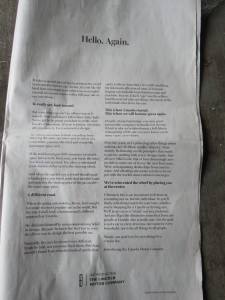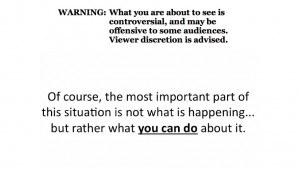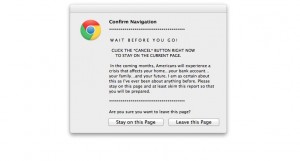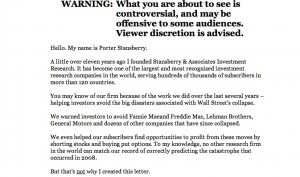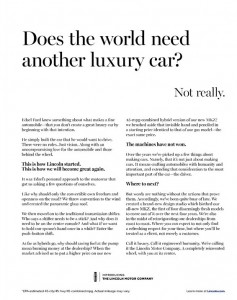
I am surely in the demo for the reimaged Lincoln, for the day after I saw the WSJ ad I ran across this in the New Yorker. It’s so dramatically superior to the “Hello. Again.” ad that the two could be compared as a copywriting clinic. Again, I’ve reproduced the actual ad since I can’t find the full text online and am too lazy to retype it. Let’s see what is better this time around.
1. There is a clear narrative. This is the story of Edsel Ford and how he had a dream, built great if eccentric cars, and now we are back presenting this new vehicle in his spirit. So much better than the “Hello. Again.” ad that darted back and forth between the past and the present, then swerved into the service commitment and ultimately made me carsick.
2. The proof points are big and dramatic. Instead of a sunroof, this new Lincoln has an entire “panoramic glass roof” that makes driving it like driving a convertible. And they have a hybrid model, getting an impressive 45 MPG, that costs not a penny more than the standard version.
One wonders how the copywriter for the other ad missed such clear differentiators and instead focused on the push button gearshift. Which makes an appearance here, by the way, but it’s tied to a benefit: “And what if we want to hold our spouse’s hand once in a while? Enter the push-button shift.” I do wish they’d chosen a more adventurous word such as “seat mate” or “companion” though… we Lincoln prospects are not totally moribund.
3. The voice of the copy is clear and consistent. There is a sure hand on the tiller this time, different from the preening narrator of “Hello. Again.” who kept distracting himself from self-important statements with news about the car. The story is told cleanly and well, up until a closing paragraph which is aspirational yet tight: “Call it luxury. Call it engineered humanity. [WTF?] We’re calling it the Lincoln Motor Company. A completely reinvented wheel, with you at the center.”
So why am I not now in my aging Packard or Escalade, headed for my Lincoln dealer (wherever that is)? Unfortunately, the “Hello. Again.” ad ran AFTER the Edsel ad per the marketing strategy, not before. If this Benjamin Button regression of copywriting smarts continues, pretty soon I will be test driving a Hupmobile. Or Maxwell, even.
